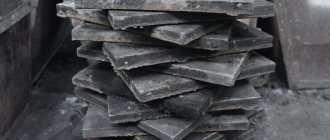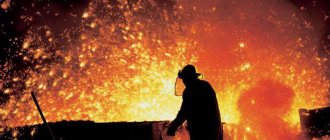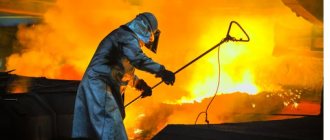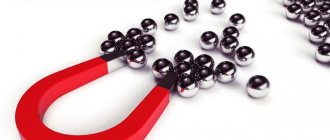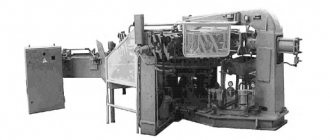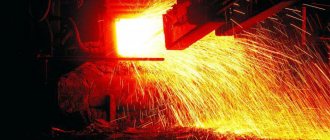Main properties and marking of alloy cast iron
Alloyed cast iron differs in that it contains alloying components - chromium, vanadium, nickel, copper and others. Specifically, these components are assigned to alloy cast iron with the following parameters:
- Increased wear resistance;
- Heat resistance;
- Corrosion resistance; properties.
Alloy cast iron is marked depending on the main components. This could be chromium alloy cast iron, vanadium, nickel and others. The first letter is H, followed by the designation of the main component; the numbers indicate the proportion of carbon in the composition.
Also among alloyed cast irons there are:
- Snow White;
- Grayish;
- Malleable.
Types of Alloy Alloy
What does alloy cast iron mean? Alloying is an operation to introduce various impurities into the composition of a material that can improve its characteristics. For cast iron, titanium, chromium, vanadium and others became such additives. The introduction of alloying elements into the composition can increase characteristics such as strength, hardness, wear resistance, corrosion resistance and many others.
Today, depending on the number of alloying elements of cast iron, three types can be distinguished:
- If additives are contained in amounts up to 2.5% of the total mass, then this is low-alloy cast iron.
- Medium alloyed are those materials whose substance content ranges from 2.5 to 10%.
- The last type is highly alloyed, if the content of modifiers in total exceeds 10%.
Alloy cast iron - introduction
Products made of alloy cast iron are most often used in places where there is a possibility of great wear, for example, when units operate under friction conditions, high temperatures or brutal environments. It is important not to forget that cast iron is quite fragile and cannot withstand enormous shock loads.
Most often, cast iron is smelted in blast furnaces; it is created from iron ore materials, which are subsequently processed into steel and are called pig iron. For the production of shaped castings, foundry cast iron is used.
Depending on where the castings will be used and what properties are necessary for operation, the components are determined. So, these can be castings with the following qualities:
- Heat resistant;
- Cold resistant;
- Heat resistant;
- Wear-resistant;
- Corrosion resistant;
- Low magnetic.
Varieties of gray cast iron
Cast alloy cast iron has several subtypes. One of them was malleable cast iron. This conditional name was given to the material, which differs in that it is softer and more viscous than gray. It is made from white cast iron. To do this, an annealing procedure is used, which lasts quite a long time. The markings here are approximately the same, for example, CC 30-6, CC 33-8, CC 37-12. The letters indicate that the cast iron is malleable, and the next two numbers determine the tensile strength. But as for the last one or two digits, they characterize the maximum relative elongation, which is measured as a percentage.
Another subtype of cast alloy cast iron is modified. In order to get it, you need to add special elements to gray. Such modifiers are added before the substance is poured. Aluminum, silicon, calcium and others can be used as additives. These additives significantly increase the number of crystallization centers. In other words, they contribute to significant reduction of graphite.
Thanks to such additives, special alloy cast iron has higher strength characteristics, less brittleness, and increased resistance to cracking. It is worth adding that all the best varieties of this alloy are obtained from precisely this modified material.
Processing of alloy cast iron products
Alloy cast iron castings can be subjected to various treatments. Among the most popular processing actions are:
- High temperature annealing – reduces hardness;
- Aging with normalization - allows you to reduce magnetic permeability and at the same time increases ductility and strength;
- Normalization – allows you to increase the hardness of any product;
- Vacation - allows you to relieve internal tension;
- Annealing with high tempering reduces the hardness and simplifies the processing of such castings made of alloy cast iron.
The time for processing and heating castings is selected for each casting separately, depending on its weight and size. All the main properties that the casting must have are determined by the end users depending on the future operating conditions of the product.
Cast iron
Cast iron began to be used many decades ago. This material has special performance characteristics that differ from those characteristic of steel. The creation of cast iron, despite the emergence of a huge number of different alloys, is established in almost all countries. In order to find the properties of cast iron, you should consider the individual characteristics of its chemical composition, on which certain physical properties depend.
The chemical composition of cast iron is a fundamental factor that almost completely describes the mechanical properties of the resulting castings. Apart from this, almost all properties are affected by the mechanisms of primary and secondary crystallization.
The carbon content of cast iron can vary from 2.14 to 6.67 percent. Modern production technologies make it possible to control with the highest precision the concentration of all parts in the composition, due to which the fragility index decreases and other performance properties increase.
When considering the chemical composition of cast iron, it is necessary to emphasize that, in addition to iron and carbon, it certainly includes the following elements:
- Silicon (concentration not more than 4.3%). This element has a favorable effect on cast iron, making it softer and improving its casting properties. But a very high concentration can make the material more susceptible to plastic deformation.
- Manganese (not more than 2%). By adding this element to the composition, the strength of the material increases significantly. But a very high concentration can become a prerequisite for the fragility of the structure.
- Sulfur is a harmful impurity that can significantly worsen the performance properties of the material. Typically, the sulfur concentration in cast iron does not exceed 0.07%. Sulfur becomes a prerequisite for the occurrence of cracks when the composition is heated.
- Phosphorus is contained in the composition in a concentration of less than 1.2%. An increase in the concentration of phosphorus in the composition becomes a prerequisite for the appearance of cracks when the composition cools. In addition, this element becomes a prerequisite for the deterioration of other mechanical properties.
Interesting to read: Gray cast iron melting point
As in almost all other compositions, the most important of the chemical parts of cast iron is carbon. The type of material depends on its concentration and type. The structure of cast iron can vary significantly depending on the production technology used.
Introduction of copper
Currently, cast iron with the addition of copper is being used more and more often. The introduction of this additive into the alloy significantly improves its casting properties. This best affects the fluidity of the material. In addition, the tendency to cracks and shrinkage porosity is significantly reduced.
The introduction of 0.5% Cu (copper) makes the cast iron suitable enough to cast parts from which the wall thickness will be from 10 to 25 mm. If it is necessary to increase the wall thickness of future elements, then the quantitative content of copper, as well as its complexes, will have to be increased. It is worth noting here that the effect of adding copper can be enhanced if elements such as antimony or bismuth are introduced into the alloy.
If the carbon equivalent increases, then the influence of copper on graphite crystallization decreases. Alloying cast iron with copper can also prevent bleaching in the surface layers, and also significantly increases the hardness towards the middle. This is quite noticeable when smelting cylinder liners, cast iron block heads and other elements.
Physical properties
Cast iron has become widespread due to its attractive physical qualities:
- The cost of the material is significantly lower than the price of other alloys. That is why it is used to create a wide variety of products.
- Considering the density of cast iron, we note that this indicator is significantly lower than that of steel, due to the fact that the material becomes much lighter.
- The melting point of cast iron can vary somewhat depending on its structure, but is almost always 1,200 degrees Celsius. Due to the inclusion of various additives in the composition, the melting temperature of cast iron can significantly increase or decrease.
- When choosing a material, almost everyone pays attention to the fact that the color of cast iron can vary slightly depending on the structure and chemical composition.
The boiling point of cast iron also depends almost entirely on its chemical composition. In order to discern the physical properties of a material, attention should be paid to each of its varieties. A different structure and chemical composition become a prerequisite for imparting other physical and mechanical properties.
Needle structure and high strength material
A small variety of gray cast iron, which belongs to the wear-resistant group, is a material with a needle-like structure. The doping level of this material is quite low. Its silicon and carbon content is also quite low. In this case, the quantitative content of substances such as copper, molybdenum, nickel and some other modifiers increases depending on the resulting wall thickness required, as well as depending on the casting method that will be used.
Another type is a high-strength material. This is a small variety of gray cast iron, which is distinguished by its nodular graphite content. In order to obtain such a structure, it is necessary to introduce magnesium, cerium and bismuth into the alloy. The addition of these three alloying elements transforms the ductile graphite of the casting material into spherical. This type is distinguished by the fact that its mechanical qualities are much higher than those of other types of cast iron. Today, approximately 10 different grades of the alloy of this category are produced. This material can be perfectly used in shipbuilding instead of the malleable type. And the most common type of high-strength cast iron is magnesium (with a large amount of magnesium in the composition).
Production development
Cast iron has been smelted for several decades, which is associated with its unique performance properties. A huge number of varieties of alloys describe the application of special marking rules. Marking of cast iron is carried out as follows:
- Foundries are designated by the letter L.
- Grayish has become widespread; the combination of letters “SCH” is used to designate it.
- Malleable is designated KCH.
- Extreme or snow-white is designated by the letter P.
- Anti-friction or grayish indicate ASF.
- Alloy cast irons can have a wide variety of chemical compositions and are designated by the letter “C”.
The development of cast iron production involves several steps that allow you to obtain the required structure. Considering the process of producing cast iron, we note the following points:
- Creation is carried out in special blast furnaces.
- Alloyed and heat-resistant cast iron can be obtained by using steel ore as a raw material.
- Development is presented in the reduction of iron oxide ore. As a result of the restructuring of the crystalline network and the configuration of the structure, the output is a material called cast iron.
- Considering production methods, we note that the individuality of the technology also lies in the materials used - cokes. Coke is understood to be natural gas or thermoanthracite, which acts as a fuel.
- Cast iron production involves tempering iron in a rigid form using a special furnace. At this step, watery cast iron comes out.
Iron making equipment can vary greatly. Apart from this, the production design used almost completely describes what kind of material will be obtained. An example is the creation of ductile iron, which is associated with giving the structure an unusual shape.
Types of cast iron
There is quite a huge number of varieties of the material in question. The systematization of cast iron depends almost entirely on the structure and chemical composition. The following types of cast iron are distinguished:
- . This type of material is characterized by low ductility and high viscosity, and also good machinability. The composition contains carbon in the form of graphite. Area of implementation – mechanical engineering; creation of wear parts. As practice shows, the phosphorus concentration can vary over a fairly wide range: from 0.3 to 1.2%. Due to its special chemical composition, the material has the highest fluidity and is often used in artistic casting. Anti-friction cast iron is relatively inexpensive, which also describes its widespread use. . Due to the fact that in this composition carbon is presented as cementite, the structure is characterized by extreme fragility and increased hardness, as well as low casting qualities and poor machinability. It is worth considering that snow-white cast iron is used for conversion into steel or for the production of malleable iron. Quite often it is called the limit.
- Half-and-half is characterized by increased wear resistance, which is associated with the distribution of carbon into a cementite and free base. This type of material is often used in mechanical engineering and machine tool building.
- Alloy. In order to give special properties to cast iron, alloying is also carried out. Alloy cast iron has increased wear resistance and corrosion resistance due to the inclusion of nickel and chromium, as well as copper. Such versions of cast iron get their name depending on how the alloying element was used in their manufacture.
- Durable cast iron is made by introducing various parts, such as magnesium and calcium, into the watery grayish cast iron. As a result of alloying, the shape of graphite changes - it resembles a sphere and at the same time does not change the crystalline network. It is worth considering that in its properties this alloy is reminiscent of carbon steel and is mainly used in the manufacture of various wear-resistant parts.
- Malleable. It is obtained by melting snow-white cast iron, which should be heated to the highest temperature and kept in a similar condition. In some cases, alloying parts are added to impart special properties to the composition. The main qualities can be called high viscosity and an increased degree of plasticity. It has become widespread in the engineering industry.
- Special. It is an alloy containing a huge amount of manganese and silicon. It is often used to remove oxygen from steel during its production or remelting, thereby reducing the melting point.
Interesting read: The difference between gray cast iron and white
Any type of cast iron has its own special structure and chemical composition, which determine the area of application.
Description of types of cast iron
The first type is pig iron. This is the name of a material in which carbon is presented in the form of a substance such as cementite. When broken, it is white in color, hence its name. This cast iron is characterized by high hardness and brittleness. It is very difficult to machine. Moreover, about 80% of all cast iron produced is white. The main purpose of this type of material is further smelting into steel.
Gray alloy cast iron is a metal in which carbon is present in the form of ductile graphite. When broken, its color is gray, which also determined its name. The fragility and hardness of such cast iron is less than that of white cast iron, but at the same time it is much more amenable to machining.
The properties of this type of alloy cast iron are as follows:
- Firstly, it perfectly resists compressive loads.
- Secondly, this metal is insensitive to surface defects, and is also distinguished by its good resistance to fatigue failure.
However, cast alloy cast iron has rather weak impact strength, as well as low ductility. Because of these two disadvantages, it is quite difficult to use such material for structural purposes.
Application
Due to its special physical and mechanical properties, cast iron can be used in a variety of areas:
- For the production of various parts in the mechanical engineering industry. For many years, this particular alloy has been used in the manufacture of a wide variety of parts for internal combustion engines. With all this, automakers change the main parameters of the material by alloying it, which is necessary to achieve unique properties. In addition, brake pads made from this alloy have become widespread.
- Cast iron products can withstand low temperatures. Therefore, the material is used in the production of equipment and tools that are used in harsh weather conditions.
- Cast iron is valued in the metallurgical field. This is coupled with low cost, which almost entirely depends on the carbon concentration and the characteristics of the resulting structure. The highest casting properties also make the material the most attractive. The resulting products are characterized by the highest strength and wear resistance.
- Over the past few decades, the alloy in question has been widely used in the manufacture of sanitary equipment. This is combined with the highest anti-corrosion capabilities, as well as the ability to produce products of a wide variety of shapes. Examples include cast iron bathtubs and radiators, various pipes, radiators and sinks. Despite the emergence of materials that could replace cast iron, such products are increasingly popular. This is due to the fact that they retain their original appearance over a long period of use.
- The alloy is also used for the production of various decorative parts, which is combined with the highest casting properties. Examples include mesh for railings, various figurines and almost everything else.
Cast iron frying pans
Cast iron radiators
Apart from this, the scope of implementation depends on the following parameters of the material in question:
- Some brands have the highest strength, which is typical for steel. This is precisely why the material is used even after the emergence of modern alloys.
- Cast iron products can retain heat for a long period. With all this, thermal energy can spread moderately throughout the material. These properties began to be used in the manufacture of heating radiators or other similar products.
- It is generally accepted that cast iron is an environmentally friendly material. That is why it is often used in the manufacture of various dishes, for example, cauldrons.
- Highest resistance to acid-base conditions.
- Highest hygiene because all contaminants can be simply removed from the surface.
- The material in question is characterized by a fairly long service life, provided that the operating instructions are followed.
- The chemical substances contained in it cannot cause harm to health.
In conclusion, we note that the long-discovered development of the production of the material in question has remained virtually constant for almost all years. This is due to the fact that at relatively low costs it was possible to obtain a larger size of the molten alloy. Nowadays, material is often created from scrap, which makes it possible to further reduce the cost of the resulting product.
Interesting read: Is it possible to brew cast iron?
1. BRANDS
1. BRANDS
1.1. The grades of alloy cast iron for castings are listed in Table 1.
Table 1
| Type of cast iron | Brand | Property of castings | |
| Chrome | low alloy | CHH1 CHH2 | Heat resistant |
| CHH3 | Heat-resistant, wear-resistant | ||
| CHH3T | Wear-resistant | ||
| highly alloyed | ChH9N5 | Wear-resistant | |
| CHH16 | Wear-resistant, heat-resistant | ||
| CHH16M2 CHH22 | Wear-resistant | ||
| ChH22S CHH28 | Corrosion-resistant and heat-resistant | ||
| CHH28P | Resistant in zinc melt | ||
| ChH28D2 | Wear-resistant and corrosion-resistant | ||
| CHH32 | Heat-resistant and wear-resistant | ||
| Siliceous | low alloy | ChS5 ChS5SH | Heat resistant |
| highly alloyed | ChS13 ChS15 ChS17 ChS15M4 ChS17M3 | Corrosion-resistant in liquid media | |
| Aluminum | low alloy | CHYUHSH | Heat resistant |
| highly alloyed | ChYu6S5 CHY7H2 | Heat-resistant and wear-resistant | |
| CHYU22SH CHY30 | Heat-resistant and wear-resistant at high temperatures | ||
| Manganese | highly alloyed | ChG6S3SH CHG7X4 | Wear-resistant |
| ChG8D3 | Low-magnetic, wear-resistant | ||
| Nickel | low alloy | CHNHT CHNHMD CHNMSH | Corrosion-resistant in gas environments of internal combustion engines |
| CHNDHMSH | Corrosion-resistant in gas environments of internal combustion engines, increased strength | ||
| CHN2X CHN4X2 | Wear-resistant | ||
| CHN3ХМДШ | Wear-resistant, high strength | ||
| highly alloyed | CHN4X2 | Wear-resistant | |
| CHN11G7SH CHN15DZSh | Heat-resistant and low-magnetic | ||
| CHN15D7 | Wear-resistant in engines and low-magnetic | ||
| ChN19H3Sh | Heat-resistant and low-magnetic | ||
| CHN20D2SH | Heat-resistant, cold-resistant, low-magnetic | ||
Note. In the designation of cast iron grades, the letters mean: CH - cast iron; alloying elements: X - chromium, C - silicon, G - manganese, N - nickel, D - copper, M - molybdenum, T - titanium, P - phosphorus, Yu - aluminum; the letter Ш indicates that the graphite in cast iron is spherical.
The numbers after the letter indicate the approximate mass fraction of the main alloying elements.
Cast irons are divided into types and grades according to the predominance of alloying and purpose.
The application, operational and mechanical properties of cast iron are given in Appendices 1, 3.
(Changed edition, Amendment No. 1).
1.2. The chemical composition of alloy cast irons must meet the requirements specified in Table 2.
table 2
Chemical composition of cast iron
| Cast iron grade | Mass fraction, % | |||||||||||
| carbon | silicon | manganese | phosphorus | sulfur | chromium | nickel | copper | vanadium | molybdenum | titanium | aluminum | |
| no more | ||||||||||||
| CHH1 | 3,0-3,8 | 1,5-2,5 | 1,0 | 0,30 | 0,12 | 0,40-1,00 | — | — | — | — | — | — |
| CHH2 | 3,0-3,8 | 2,0-3,0 | 1,0 | 0,30 | 0,12 | 1,01-2,00 | — | — | — | — | — | — |
| CHH3 | 3,0-3,8 | 2,8-3,8 | 1,0 | 0,30 | 0,12 | 2,01-3,00 | — | — | — | — | — | — |
| CHH3T | 2,6-3,6 | 0,7-1,5 | 1,0 | 0,30 | 0,12 | 2,01-3,00 | — | 0,5-0,8 | — | — | 0,7-1,0 | — |
| ChH9N5 | 2,8-3,6 | 1,2-2,0 | 0,5-1,5 | 0,06 | 0,10 | 8,0-9,50 | 4,0-6,0 | — | — | 0,0-0,4 | — | — |
| CHH16 | 1,6-2,4 | 1,5-2,2 | 1,0 | 0,10 | 0,05 | 13,0-19,0 | — | — | — | — | — | — |
| CHH16M2 | 2,4-3,6 | 0,5-1,5 | 1,5-2,5 | 0,10 | 0,05 | 13,0-19,0 | — | 1,0-1,5 | — | 0,5-2,0* | — | — |
| CHH22 | 2,4-3,6 | 0,2-1,0 | 1,5-2,5 | 0,10 | 0,08 | 19,0-25,0 | — | — | 0,15- 0,35 | — | 0,15- 0,35 | — |
| ChH22S | 0,6-1,0 | 3,0-4,0 | 1,0 | 0,10 | 0,08 | 19,0-25,0 | — | — | — | — | — | — |
| CHH28 | 0,5-1,6 | 0,5-1,5 | 1,0 | 0,10 | 0,08 | 25,0-30,0 | — | — | — | — | — | — |
| CHH28P | 1,8-3,0 | 1,5-2,5 | 1,0 | 0,8-1,5 | 0,08 | 25,0-30,0 | — | — | — | — | — | — |
| ChH28D2 | 2,2-3,0 | 0,5-1,5 | 1,5-2,5 | 0,10 | 0,08 | 25,0-30,0 | 0,4-0,8 | 1,5-2,5 | — | — | — | — |
| CHH32 | 1,6-3,2 | 1,5-2,5 | 1,0 | 0,10 | 0,08 | 30,0-34,0 | — | — | — | — | 0,1-0,3 | — |
| ChS5 | 2,5-3,2 | 4,5-6,0 | 0,8 | 0,30 | 0,12 | 0,5-1,0 | — | — | — | — | — | — |
| ChS5SH | 2,7-3,3 | 4,5-5,5 | 0,8 | 0,10 | 0,03 | 0,0-0,2 | — | — | — | — | — | 0,1-0,3 |
| ChS13 | 0,6-1,4 | 12,0-14,0 | 0,8 | 0,10 | 0,07 | — | — | — | — | — | — | — |
| ChS15 | 0,3-0,8 | 14,1-16,0 | 0,8 | 0,10 | 0,07 | — | — | — | — | — | — | — |
| ChS15M4 | 0,5-0,9 | 14,0-16,0 | 0,8 | 0,10 | 0,10 | — | — | — | — | 3,0-4,0 | — | — |
| ChS17 | 0,3-0,5 | 16,1-18,0 | 0,8 | 0,10 | 0,07 | — | — | — | — | — | — | — |
| ChS17M3 | 0,3-0,6 | 16,0-18,0 | 1,0 | 0,30 | 0,10 | — | — | — | — | 2,0-3,0 | — | — |
| CHYUHSH | 3,0-3,8 | 2,0-3,0 | 0,5 | 0,10 | 0,03 | 0,4-1,0 | — | — | — | — | — | 0,6-1,5 |
| ChYu6S5 | 1,8-2,4 | 4,5-6,0 | 0,8 | 0,30 | 0,12 | — | — | — | — | — | — | 5,5-7,0 |
| CHY7H2 | 2,5-3,0 | 1,5-3,0 | 1,0 | 0,30 | 0,02 | 1,5-3,0 | — | — | — | — | — | 5,0-9,0 |
| CHYU22SH | 1,6-2,5 | 1,0-2,0 | 0,8 | 0,20 | 0,03 | — | — | — | — | — | — | 19,0- 25,0 |
| CHY30 | 1,0-1,2 | 0,0-0,5 | 0,7 | 0,04 | 0,08 | — | — | — | — | — | 0,05- 0,12 | 29,0- 31,0 |
| ChG6S3SH | 2,2-3,0 | 2,0-3,5 | 4,0-7,0 | 0,06 | 0,03 | 0,0-0,15 | — | — | — | 0,5-1,0 | — | 0,5-1,5 |
| CHG7X4 | 3,0-3,8 | 1,4-2,0 | 6,0-8,0 | 0,10 | 0,05 | 3,0-5,0 | — | — | — | — | — | — |
| ChG8D3 | 3,0-3,8 | 2,0-2,5 | 7,0-9,0 | 0,30 | 0,10 | — | 0,8-1,5 | 2,5-3,5 | — | — | — | 0,5-1,0 |
| CHNHT | 2,7-3,4 | 1,4-2,0 | 0,8-1,6 | 0,3-0,6 | 0,15 | 0,2-0,6 | 0,3-0,7 | — | — | — | 0,05- 0,12 | — |
| CHNHMD | 2,8-3,2 | 1,6-2,0 | 0,8-1,2 | 0,15 | 0,12 | 0,2-0,7 | 0,7-1,6 | 0,2-0,5 | — | 0,2-0,7 | — | — |
| CHNHMDSH | 3,0-3,6 | 2,0-2,8 | 0,6 | 0,08 | 0,03 | 0,2-0,4 | 0,6-1,0 | 0,5-0,8 | — | 0,2-0,6 | — | — |
| CHNMSH | 2,8-3,8 | 1,7-3,2 | 0,8-1,2 | 0,10 | 0,03 | 0,0-0,1 | 0,8-1,5 | — | — | 0,3-0,7 | — | — |
| CHN2X | 3,0-3,6 | 1,2-2,0 | 0,6-1,0 | 0,25 | 0,12 | 0,4-0,6 | 1,5-2,0 | — | — | — | — | — |
| CHN3ХМДШ | 3,0-3,6 | 2,0-2,8 | 0,8 | 0,08 | 0,03 | 0,2-0,5 | 2,5-4,5 | 0,7-1,5 | — | 0,4-1,0 | — | — |
| CHN4X2 | 2,8-3,6 | 0,0-1,0 | 0,8-1,3 | 0,30 | 0,15 | 0,8-2,5 | 3,5-5,0 | — | — | — | — | — |
| CHN11G7SH | 2,3-3,0 | 1,8-2,5 | 5,0-8,0 | 0,08 | 0,03 | 1,5-2,5 | 10,0-12,0 | — | — | — | — | — |
| CHN15D7 | 2,2-3,0 | 2,0-2,7 | 0,5-1,6 | 0,30 | 0,10 | 1,5-3,0 | 14,0-16,0 | 5,0-8,0 | — | — | — | — |
| CHN15D3SH | 2,5-3,0 | 1,4-3,0 | 1,3-1,8 | 0,08 | 0,03 | 0,6-1,0 | 14,0-16,0 | 3,0-3,5 | — | — | — | — |
| ChN19H3Sh | 2,3-3,0 | 1,8-2,5 | 1,0-1,6 | 0,10 | 0,03 | 1,5-3,0 | 18,0-20,0 | — | — | — | — | — |
| CHN20D2SH | 1,8-2,5 | 3,0-3,5 | 1,5-2,0 | 0,03 | 0,01 | 0,5-1,0 | 19,0-21,0 | 1,5-2,0 | — | — | — | 0,0-0,3 |
_______________ * With a mass fraction of chromium of 13-16% and 16-19%, the recommended mass fraction of molybdenum is 2.0-1.5% and 1.5-0.5%, respectively.
Note. 1. Low-alloy cast irons of all types, as well as high-alloy manganese and nickel, with the exception of grades ChN2Kh, ChN3T, ChG7Kh4, ChN4Kh2, are modified with 75% ferrosilicon or other graphitizing additives.
2. In chromium cast irons and in cast irons with nodular graphite, a mass fraction of nickel up to 1.0% or copper up to 1.5% is allowed, introduced by naturally alloyed cast iron, alloyed steel scrap or magnesium-containing alloy.
(Amendment).
At the consumer's request, grades of high-nickel cast iron are used in accordance with Appendix 4.
1.3. The grade of cast iron is determined by its chemical composition.
It is possible to control the special and mechanical properties, hardness, and shape of graphite; the need and frequency of control are established in the normative and technical documentation for the casting.
1.4. Nodular cast iron must contain at least 80% spherical inclusions.
1.5. Types of heat treatment of cast iron are given in Appendix 2. The need for heat treatment is established in the normative and technical documentation for the casting.
1.6. The mechanical properties of cast iron, determined at the request of the consumer, must correspond to the values specified in Table 3 or Table 2 of Appendix 4.
Table 3
Mechanical properties of cast iron
| Cast iron grade | Tensile strength, MPa, not less | Relative extension , % | Hardness HB | |
| stretching | bending | |||
| CHH1 | 170 | 350 | — | 207-286 |
| CHH2 | 150 | 310 | — | 207-286 |
| CHH3 | 150 | 310 | — | 228-364 |
| CHH3T | 200 | 400 | — | 440-590 |
| ChH9N5 | 350 | 700 | — | 490-610 |
| CHH16 | 350 | 700 | — | 400-450 |
| CHH16M2 | 170 | 490 | — | 490-610 |
| CHH22 | 290 | 540 | — | 330-610 |
| ChH22S | 290 | 540 | — | 215-340 |
| CHH28 | 370 | 560 | — | 215-270 |
| CHH28P | 200 | 400 | — | 245-390 |
| ChH28D2 | 390 | 690 | — | 390-640 |
| CHH32 | 290 | 490 | — | 245-340 |
| ChS5 | 150 | 290 | — | 140-300 |
| ChS5SH | 290 | — | — | 228-300 |
| ChS13 | 100 | 210 | — | 290-390 |
| ChS15 | 60 | 170 | — | 290-390 |
| ChS17 | 40 | 140 | — | 390-450 |
| ChS15M4 | 60 | 140 | — | 390-450 |
| ChS17M3 | 60 | 100 | — | 390-450 |
| CHYUHSH | 390 | 590 | — | 187-364 |
| ChYu6S5 | 120 | 240 | — | 235-300 |
| CHY7H2 | 120 | 170 | — | 240-286 |
| CHYU22SH | 290 | 390 | — | 241-364 |
| CHY30 | 200 | 350 | — | 364-550 |
| ChG6S3SH | 490 | 680 | — | 219-259 |
| CHG7X4 | 150 | 330 | — | 390-450 |
| ChG8D3 | 150 | 330 | — | 176-285 |
| CHNHT | 280 | 430 | — | 201-286 |
| CHNHMD | 290 | 690 | — | 201-286 |
| CHNHMDSH | 600 | — | — | 270-320 |
| CHNMSH | 490 | — | 2 | 183-286 |
| CHN2X | 290 | 490 | — | 215-280 |
| CHN3ХМДШ | 550 | — | — | 350-550 |
| CHN4X2 | 200 | 400 | — | 400-650 |
| CHN11G7SH | 390 | — | 4 | 120-255 |
| CHN15D7 | 150 | 350 | — | 120-297 |
| CHN15D3SH | 340 | — | 4 | 120-255 |
| ChN19H3Sh | 340 | — | 4 | 120-255 |
| CHN20D2SH | 500 | — | 25 | 120-220 |
Note. Strength and hardness of high-chromium, manganese and nickel cast irons after normalization and low-temperature tempering.
1.7. Grades of heat-resistant cast iron must have resistance to scale formation of no more than 0.5 g/m h of weight increase and growth of no more than 0.2% at operating temperature for 150 hours.
1.2-1.7. (Introduced additionally, Amendment No. 1).
Section 2, 3 (Excluded, Amendment No. 1).
About casting production
What is alloyed cast iron? It is cast iron that has undergone the additional introduction of one or more parts.
The use of alloy cast iron for various cast parts is based on the fact that alloying elements improve mechanical, physical, chemical and performance properties.
Depending on the degree of alloying, cast iron can be divided into three groups. Low-alloyed with an alloying content of up to 3%, medium-alloyed with an alloying content of 3-10% and high-alloyed with an alloying content above 10%.
Alloying substances, marking
According to GOST, alloy cast iron must contain a certain amount of substances for use in a certain area. In addition, the markings are also standard. For example, ChN15D7X is a high-strength alloy that contains 15% nickel, 7% copper and approximately 1% chromium. As you can see, in the marking alloying elements are marked with one letter, followed by a number indicating the quantitative content of the additive. However, it may also be that the number is missing, as after chrome. This means that the content of the substance in the composition is about 1%.
As for the production of such cast iron, it is quite inexpensive. At the same time, the final product has fairly high performance properties. Thanks to these two factors, the scope of application of the described material is constantly increasing.
Impact of alloyed parts on the properties of cast irons
Depending on the content of the predominant element, alloy cast iron is divided into nickel, chromium, chromium-nickel, cuprous, molybdenum, manganese, duralumin and others.
Currently, cast iron alloyed with nickel and nickel is most widely used. This cast iron is mostly used for Russian machine-building parts that are subject to wear due to friction.
In some variants, to give this cast iron additional parameters, other elements are also introduced into its composition, but then it is no longer called chromium-nickel, but by the name of the introduced element, for example, molybdenum, vanadium, etc.
Low alloy cast iron
The different compositions of low-alloy cast iron are given, indicating their purpose. Molybdenum is introduced into cast iron in those cases where increased heat resistance is required, i.e. preservation of mechanical parameters at elevated temperatures.
As an antifriction material, a special low-alloy antifriction cast iron is used as a substitute for tin bronze. Table2
The structure of antifriction cast iron must be pearlitic, with a uniform distribution of graphite.



